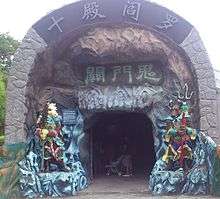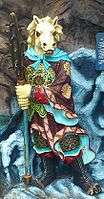Ox-Head and Horse-Face
Ox-Head (simplified Chinese: 牛头; traditional Chinese: 牛頭; pinyin: niútóu; Wade–Giles: niu2-t'ou2) and Horse-Face (simplified Chinese: 马面; traditional Chinese: 馬面; pinyin: mǎmiàn; Wade–Giles: ma3-mien4) are two guardians or types of guardians of the underworld in Chinese mythology. As indicated by their names, both have the bodies of men, but Ox-Head has the head of an ox while Horse-Face has the face of a horse. They are the first beings a dead soul encounters upon entering the underworld; in many stories they directly escort the newly dead to the underworld.[1]

Role

In their duties as guardians of Diyu, the realm of the dead, their role is to capture human souls reached the end of their earthly existence, to bring them before the courts of Hell. Souls are then awarded based on actions performed in their lifetime.
Ox-Head and Horse-Face also play the role of messengers of the king of hell, Yanluo Wang. Ox head has also been "created" by the latter took pity by the arrival of a newly dead ox, who had worked hard all his life: he made one of his faithful servants.[2]
Chinese mythology
In the Chinese classical novel Journey to the West, Ox-Head and Horse-Face are among the underworld denizens overpowered by Sun Wukong after his soul is dragged to hell in his sleep. He then crosses out his name and those of all non-human primates on earth from the record of living souls, hence granting a second level of immortality to himself and general immortality to his monkey children.
Japanese mythology
In Japanese mythology, Ox-Head and Horse-Face are known as "Gozu" and "Mezu" respectively.
Gallery
 Statue of Ox-Head at Haw Par Villa, Singapore.
Statue of Ox-Head at Haw Par Villa, Singapore. Statue of Horse-Face at Haw Par Villa, Singapore.
Statue of Horse-Face at Haw Par Villa, Singapore.- Statue of Ox-Head in Taiwan.
- Statue of Horse-Face in Taiwan.
- Statue of Horse-face, Fengdu Ghost City.
See also
References
- Bane, Theresa (2014). Encyclopedia of Demons in World Religions and Cultures. McFarland. p. 416. ISBN 9780786488940.
- Leroi-Gourhan, André (2004). Pages oubliées sur le Japon (in French). Editions Jérôme Millon. p. 469. ISBN 9782841371556.